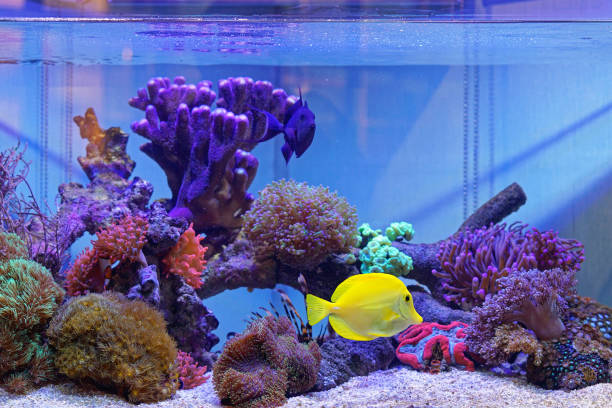Creating a harmonious community tank involves understanding diverse fish species and their unique interactions. Compatibility is crucial for a peaceful aquarium environment where inhabitants coexist. Researching species behavior helps prevent conflicts and fosters a balanced ecosystem within the tank. Mixing fish with similar temperaments and dietary needs promotes a stress-free cohabitation experience. Striking a balance between schooling, solitary, and territorial fish contributes to overall tank stability. Varied swimming levels among species add depth to the tank’s aesthetic appeal and ensure efficient space utilization.
Consideration of size and aggression levels prevents overcrowding and aggression issues among tank residents. Offering hiding spots and diverse habitats accommodates the natural instincts and preferences of different species. Regular observation helps identify signs of stress or aggression, allowing timely intervention to maintain harmony. A well-maintained community tank not only showcases aquatic diversity but also provides a captivating and serene aquatic environment. In summary, achieving community tank dynamics that promote harmony involves thoughtful planning and attentive care.
Fish Species Compatibility
Ensuring fish species compatibility is vital for a thriving aquarium. Begin by researching the temperaments and habits of potential tank inhabitants. Selecting species with similar temperaments fosters a peaceful coexistence. Peaceful community tanks often feature compatible fish that share dietary preferences and behaviors. Observing each species’ social dynamics helps avoid conflicts, promoting a harmonious aquatic environment.

Consider the size of your tank to prevent overcrowding, allowing each fish sufficient space. A balanced mix of schooling, solitary, and territorial species contributes to a dynamic aquarium. Varied swimming levels and distinct niches cater to the diverse needs of different species. Providing hiding spots and structures adds complexity, minimizing territorial disputes and stress among fish. Regular observation of interactions aids in identifying potential issues early on. If conflicts arise, intervene promptly by adjusting the tank’s layout or relocating aggressive fish.
Maintaining a balanced community tank requires ongoing attention to behavioral cues and environmental adjustments. Successful compatibility ensures a visually appealing, stress-free aquarium where diverse fish species cohabitate harmoniously. In summary, harmonizing fish species compatibility involves thoughtful selection, observation, and proactive intervention for sustained balance.
Behavioral Research
Conducting behavioral research is crucial for a thriving aquarium where fish coexist peacefully. Begin by observing each species’ individual behaviors to understand their natural tendencies. Different fish exhibit varied social structures, from schooling to solitary behaviors, influencing tank dynamics. Identify feeding patterns and preferences to ensure all fish receive adequate nutrition.
Recognizing territorial traits helps in strategic placement of hiding spots and structures within the tank. Some species may be more aggressive during breeding, requiring careful consideration of tank mates. Behavioral compatibility is key; matching fish with similar habits minimizes stress and potential conflicts. Introduce new fish gradually, allowing them to acclimate and reduce disruption to existing dynamics. Regularly monitor fish interactions, noting any signs of stress, aggression, or unusual behavior promptly.
Adjust the tank layout if conflicts arise, creating a balanced environment that accommodates each species. Providing a stimulating environment with hiding spots and structures enriches fish behavior and reduces stress. Successful behavioral research promotes a harmonious aquarium, showcasing the natural behaviors of diverse fish species. In conclusion, understanding and incorporating behavioral research enhances the overall well-being of aquarium inhabitants, fostering a serene and captivating aquatic environment.
Habitat Diversity
Creating habitat diversity is essential for a vibrant aquarium that caters to various fish species. Different fish thrive in different environments; understanding their natural habitats guides tank setup. Include hiding spots like caves and plants to mimic the sheltered areas found in nature. Varied substrate options, such as sand or gravel, cater to the preferences of diverse species.
Incorporate structures like driftwood and rocks to provide territories and surfaces for algae growth. Mimicking natural elements enhances the aesthetic appeal and comfort of the aquarium’s inhabitants. Consider the swimming levels preferred by different fish—some stay near the bottom, while others explore mid or upper levels. Balancing open spaces with densely planted areas accommodates the needs of both active and shy fish. Floating plants or decorations at the water’s surface offer shade and mimic natural canopies. Diverse habitats not only enrich fish behavior but also contribute to the overall tank ecosystem.
Regularly maintain and clean these elements to ensure a healthy and thriving aquatic environment. Habitat diversity is crucial for creating a visually captivating and biologically balanced aquarium. In conclusion, understanding and replicating the diverse habitats of different fish species contribute to a harmonious and engaging aquatic setting.
Size and Aggression Management
Managing size and aggression is key to maintaining a harmonious aquarium environment for various fish species. Consider the adult size of each species when planning the tank to prevent overcrowding. Larger tanks offer more space, reducing territorial disputes among fish and allowing for natural behavior. Research the aggression levels of potential tank inhabitants to choose compatible species with similar temperaments.

Avoid pairing aggressive species or those with a significant size difference to minimize conflict. Introduce fish gradually, starting with less aggressive species, to establish a balanced social hierarchy. Pay attention to any signs of aggression during the introduction process and intervene if necessary. Provide hiding spots and structures strategically to offer refuge for fish feeling threatened or stressed. Regular monitoring helps identify any changes in behavior or signs of aggression among tank residents. Separating aggressive individuals or rearranging the tank layout can help diffuse tension and restore harmony.
Feeding practices also play a role; ensure all fish receive adequate nutrition without fostering competition. Size and aggression management contribute to a stress-free environment where fish can coexist peacefully. In conclusion, careful consideration of size and aggression levels, along with thoughtful tank planning, ensures a balanced and enjoyable community tank experience.
Observation and Intervention
Observation and intervention are crucial aspects of maintaining a healthy and harmonious community aquarium. Regularly observe fish behaviors to detect signs of stress, aggression, or illness. Watch for changes in swimming patterns, appetite, or unusual interactions among tank residents. Quick identification of potential issues allows for timely intervention, preventing escalation and ensuring the well-being of the fish. Intervene by adjusting the tank layout, adding hiding spots, or separating aggressive individuals if necessary.
Close monitoring during the introduction of new fish helps prevent disruptions to existing social dynamics. Act promptly if you notice any fish being bullied or isolated, as this can lead to stress-related health problems. Providing a well-structured environment with diverse hiding spots minimizes the need for frequent interventions. Address any changes in water parameters promptly, as water quality directly impacts fish health and behavior. Regular water testing and maintenance contribute to a stable environment, reducing the likelihood of issues.
Educate yourself on common fish diseases and their symptoms to detect and address health concerns swiftly. A proactive approach to observation and intervention ensures a thriving and enjoyable aquarium experience. In conclusion, a vigilant eye on fish behavior, coupled with timely and appropriate interventions, is key to sustaining a harmonious and healthy community tank.
Conclusion
In conclusion, achieving harmony in a community tank involves thoughtful planning and continuous observation. Understanding the behaviors and needs of diverse fish species is paramount for a successful cohabitation. Species compatibility, guided by research, ensures a peaceful environment where tank residents thrive. Habitat diversity, with varied hiding spots and structures, enriches the aquarium and caters to individual preferences.
Managing size and aggression contributes to a balanced social hierarchy, preventing conflicts among tank mates. Regular observation of fish interactions allows for early detection of issues, facilitating timely intervention. Adjusting the tank layout, introducing fish gradually, and providing proper nutrition are essential intervention strategies. The success of a community tank lies in the ability to create an environment that mirrors the natural habitats of its inhabitants.
A well-maintained tank not only showcases aquatic diversity but also provides a captivating and serene space. The rewarding experience of witnessing harmonious interactions among different fish species highlights the importance of careful consideration and proactive care. In essence, community tank dynamics thrive when guided by knowledge, attention, and a commitment to the well-being of its aquatic residents.





